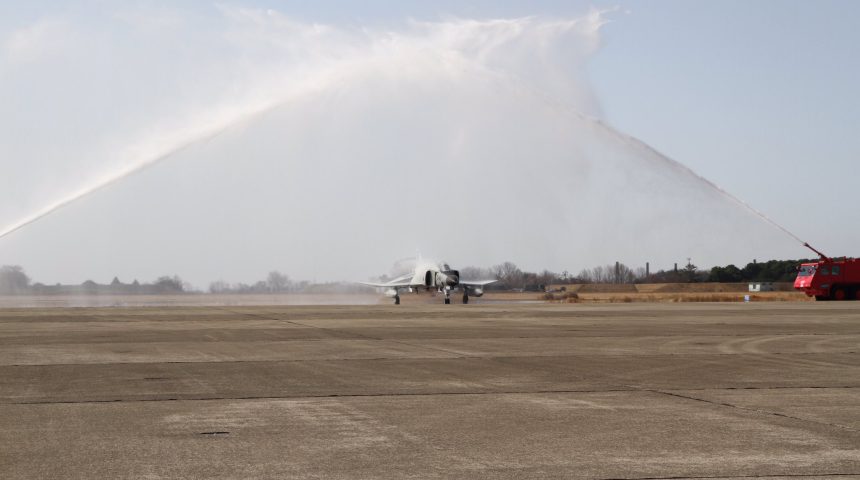The end of an era: the last three JASDF (Japanse Air Self-Defense Force) F-4EJ Phantoms, including the oldest Phantom in Japanese service, have been retired at Gifu Air Base.
On March 17, 2021, the remaining three F-4EJ Phantom aircraft of the JASDF made their last flight at Gifu Air Base, north of Nagoya. With the retirement of the airframes 17-8301/301, 47-8336/336 and 07-8431/431 the career of the F-4 in the JASDF has eventually come to an end. The aircraft operated with the Air Development and Test Wing (the unit that specializes in pre-operational testing and verification of JASDF equipment).
The three Samurai Phantoms (two F-4EJ and an F-4EJ “Kai”) took off at around 8:55 AM LT, and flew for about 40 minutes. Then they performed several passes over the base before landing for the last time. After landing, they passed through the water arch by the water cannon and were greeted by the JASDF personnel gathered on the apron with an applause.
Local spotters took some interesting footage and photographs of the three Phantoms performing their last flight.
Interestingly, Phantom #301, an F-4EJ that has not been modernized to the “Kai” (“extra”) variant, is also the first F-4 imported from the U.S. in 1971, hence the oldest Phantom in Japanese service. The aircraft was given special markings to celebrate the 50 years of service since the F-4 Phantom was first delivered to the JASDF in 1971: it sports a large “Thank You 1971-2021” text under the central fuselage, “Phantom Forever” on both sides of the air intakes.
Gifu Air Base
Last flight
本当ですかぁ!(文字が記載)
FINAL Mission 明日でしょ!
MAR 16 2021 pic.twitter.com/RgdtkT70Z0
— haruka (@haruka99422760) March 16, 2021
Phantom #301, is one of the first two aircraft produced by McDonnell Douglas (with eleven others being assembled locally by Mitsubishi Heavy Industries from parts manufactured and shipped from the U.S.) and has not received the upgrades: it has flown until today with more or less the same “hardware” it had 50 years ago. It was quite popular among local spotters because of its peculiar tail marking that is often referred to as the “shock wave and satellite orbit”.
3/17 Gifu Air Base
ADTW F-4Phantom Ⅱ LastFlight
F-4EJ 17-8301
F-4EJ 47-8336
F-4EJ改 07-8431 pic.twitter.com/2gWDnniH7H
— タルタル (@tarutaru255) March 17, 2021
Some interesting badges were also prepared to celebrate the retirement of the last remaining Phantoms.
Phantom Forever … pic.twitter.com/frKdoQUVKc
— 自衛隊岐阜地方協力本部【公式】🐧 (@gifupco) March 17, 2021
As reported in details back then, the JASDF celebrated the retirement of the F-4EJ Kai Phantom II from frontline service last year.
On Nov. 20, 2020, the last squadron flying the Phantom, the 301 Hikotai “Samurai” (or Tactical Fighter Squadron), celebrated the last flight at Hyakuri Air Base. Two special colored aircraft were prepared to bid farewell to the F-4EJ. A first one (37-8315) showed yellow and black bands on the upper fuselage, wings and external fuel tanks, a shark mouth, the writing “Go for it!! 301sq” on the exterior of the air intakes and the frog (the Japanese common toad found on Mount Tsukuba near Hyakuri) from the unit’s insignia on the tail. The second one (07-8436) was a farewell special color, with blue, cyan, white and black bands on the upper fuselage, wings and external fuel tanks, a shark mouth, the writings “Phantom forever” on the exterior of the air intakes and “Thank you Phantom II” on the upper surface of the wings and the Phantom “Spook” on the tail.
In fact, in the mid-1980s 96 out of 138 F-4EJ built locally under license by Mitsubishi were upgraded with the installation of a new AN/APG-66J pulse-Doppler radar, a new central computer, a Kaiser HUD (Head Up Display), an AN/APZ-79 IFF system, as well as the ability to carry an AN/ALQ-131 advanced multimode electronic countermeasures pod and to launch the AIM-7E/F Sparrow and the AIM-9L/P Sidewinder AAMs (air-to-air missiles).









